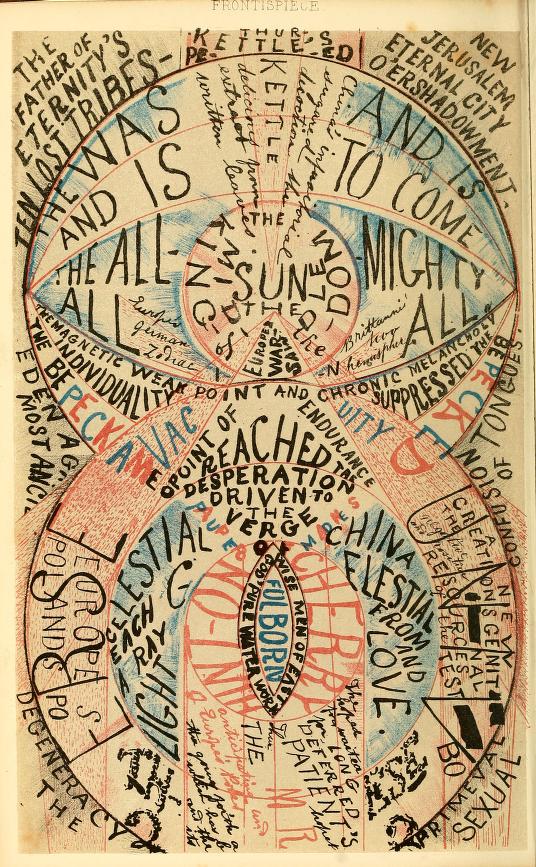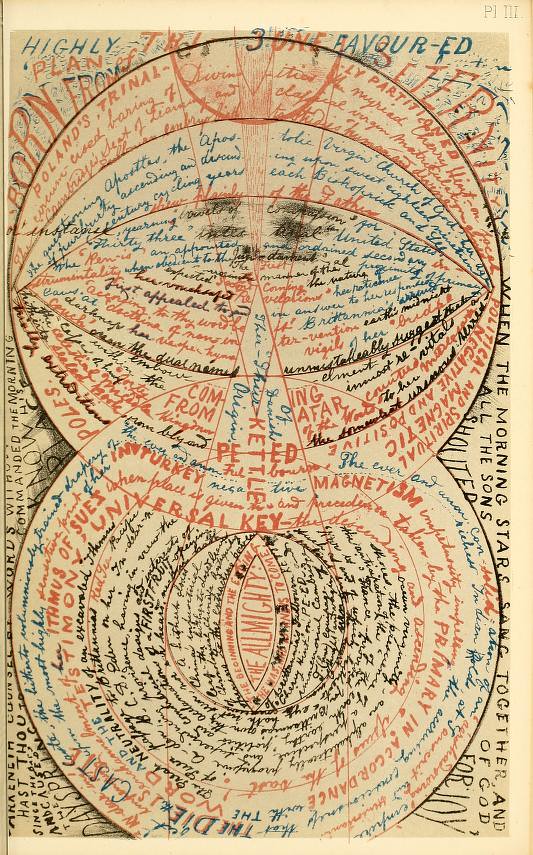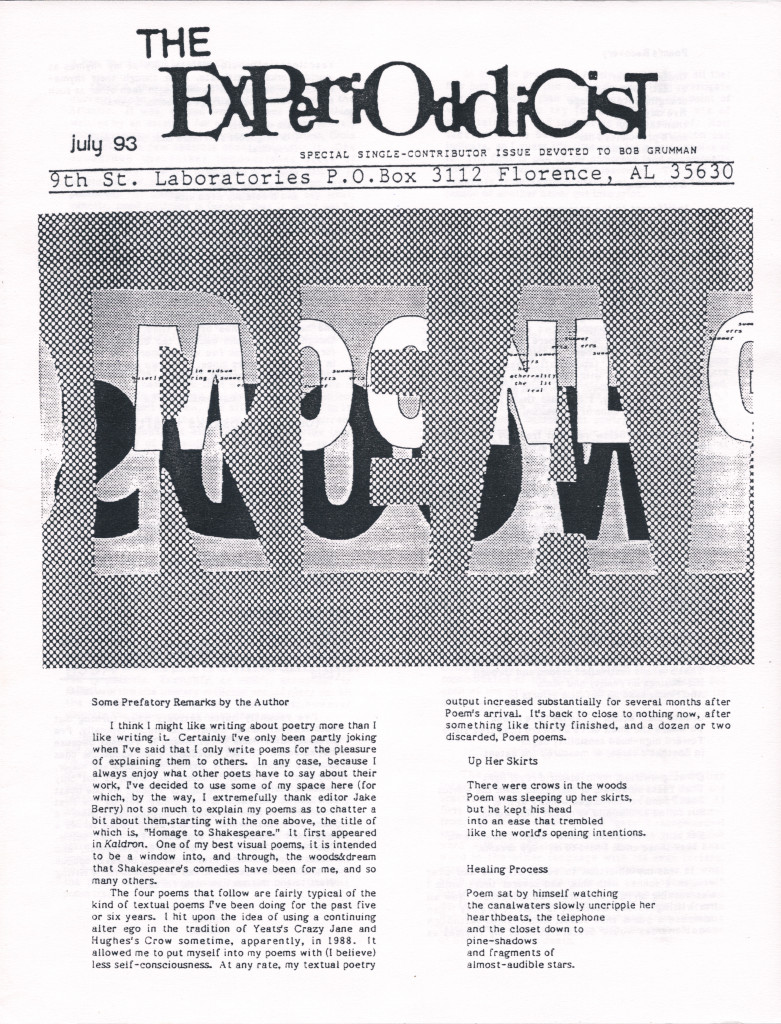I stole the material below fromThe Public Domain Review
These two images are from the book
On the Writing of the Insane (1870) by G. Mackenzie Bacon, medical superintendant at an asylum (now Fulbourn Hospital) located near Cambridge, England. The pictures are the product of a “respectable artisan of considerable intelligence [who] was sent to the Cambridgeshire Asylum after being nearly three years in a melancholy mood”. Bacon describes how the unnamed patient, for the two years he was committed, spent “much of his time writing — sometimes verses, at others long letters of the most rambling character, and in drawing extraordinary diagrams.” The two images shown here were drawn on both sides of the same small half sheet of paper, and the patient, “as though anxious, in the exuberance of his fancy, to make the fullest use of his opportunities, […] filled up every morsel of the surface — to the very edge — not leaving an atom of margin.”


Bacon goes on to explain that the man, after leaving the asylum, went “to work at his trade, and, by steady application, succeeded in arriving at a certain degree of prosperity, but some two or three years later he began to write very strangely again, and had some of his odd productions printed ; yet all this time he kept at work, earned plenty of money, conducted his business very sensibly, and would converse reasonably.”
After a visit from a medical man who tried to dissuade him from writing this way the man wrote the following letter:
Dear Doctor, To write or not to write, that is the question. Whether tis nobler in the mind to follow the visit of the great ‘Fulbourn’ with ‘chronic melancholy’ expressions of regret (withheld when he was here) that, as the Fates would have it, we were so little prepared to receive him, and to evince my humble desire to do honour to his visit. My Fulbourn star, but an instant seen, like a meteor’s flash, a blank when gone. The dust of ages covering my little sanctum parlour room, the available drapery to greet the Doctor, stowed away through the midst of the regenerating (water and scrubbing – cleanliness next to godliness, political and spiritual) cleansing of a little world. The Great Physician walked, bedimmed by the ‘dark ages’ the long passage of Western Enterprise, leading to the curvatures of rising Eastern morn. The rounded configuration of Lunar (tics) garden’s lives an o’ershadowment on Britannia’s vortex…
Unfortunately things ended sadly for the man. As Bacon recounts: “In the course of another year he had some domestic troubles, which upset him a good deal, and he ended by drowning himself one day in a public spot”.
(Images taken from On the Writing of the Insane (1870), housed at the Internet Archive, contributed by the Francis A. Countway Library of Medicine via the Medical Heritage Library. Hat-tip to Pinterest user Marisela Norte).
* * *
A hat-tip from me to Karl Kempton, too, for discovering this site and directing me to it.
* * *
I thought I’d add a few thoughts–
———–Hey, remember me quest to find 26 words, each with a different silenced letter of the alphabet? “Thought” reminds me that I found “although” wherein the u is silent. Before that I thought of “squire,” then disqualified it on the grounds that its u partakes of the pronunciation of its q. As I wrote that, I thought of quixote as a word in which an x is silent, but am not quite willing to accept it because it’s a name. It does suggest that there must be more normal words from Spanish in our language in which an x is silent.
Back to my thoughts on the asylum patient’s works. They seem to me special instances of shaped poems, or not really very poetic because essentially decorative arrangements of informrature. That tends to be my problem with the many Christian arrangements of Jesus’s name or religious texts from medieval times. Even if we take the asylum patient’s work as visual poetry, I would not call him a precursor of Modern Visual Poetry. The most important reason I would not is that he influenced no one that we know of in modern visual poetry. I hold that an artist must not only make major art to be major, but influence others. He must have not only a talent for art, but a talent for making that art sufficiently a part of the culture of to influence other artists. Eventually influence them, as Dickinson did, with a minimal talent for making her art part of the culture of her times, but enough to get just enough of it known–particularly to Higginson (if, going from memory, I have his name right), her one influential friend–to make it available to influence other poets after her death.
I don’t think the mental patient has influenced anyone even though others have done works like his because they made their works without knowing his, nor knowing works like his by people influenced by him.
Similarly, it’s questionable that Lewis Carroll’s visual poetry influenced any serious poet. The first full-scale modern visual poet in my view (so far as I know) was Apollinaire, and I don’t think he was aware of Carroll’s work. I deem Apollinaire full-scale, Mallarme not, by the way, because I (quite subjectively) consider Mallarme using words in a visually connotative but not really metaphorical way, whereas Apollinaire took a partial step from visual connotative use of words to metaphorical use of them. I think I’m saying Mallarme was visieopoetically suggestive, Apollinaire visiopoetically explicit.
To create a visual sprawl around what I’m trying to say in hopes it will be enough to help me (or someone using what I’ve said here) to improved expression. . . .
.



hey
hang in, Man as,
I too spend most of my time (now) looking for things “lost”
&usually find them in the last place that I left them..
.
I wrote a poem/ a fragment back in 1968 I KNOW that
I did
as I remember it
is on a slip of yellow legal pad-paper
again
hang in & keepontruckin and
I’ll write again when I have less time…
look for me in the funnies !